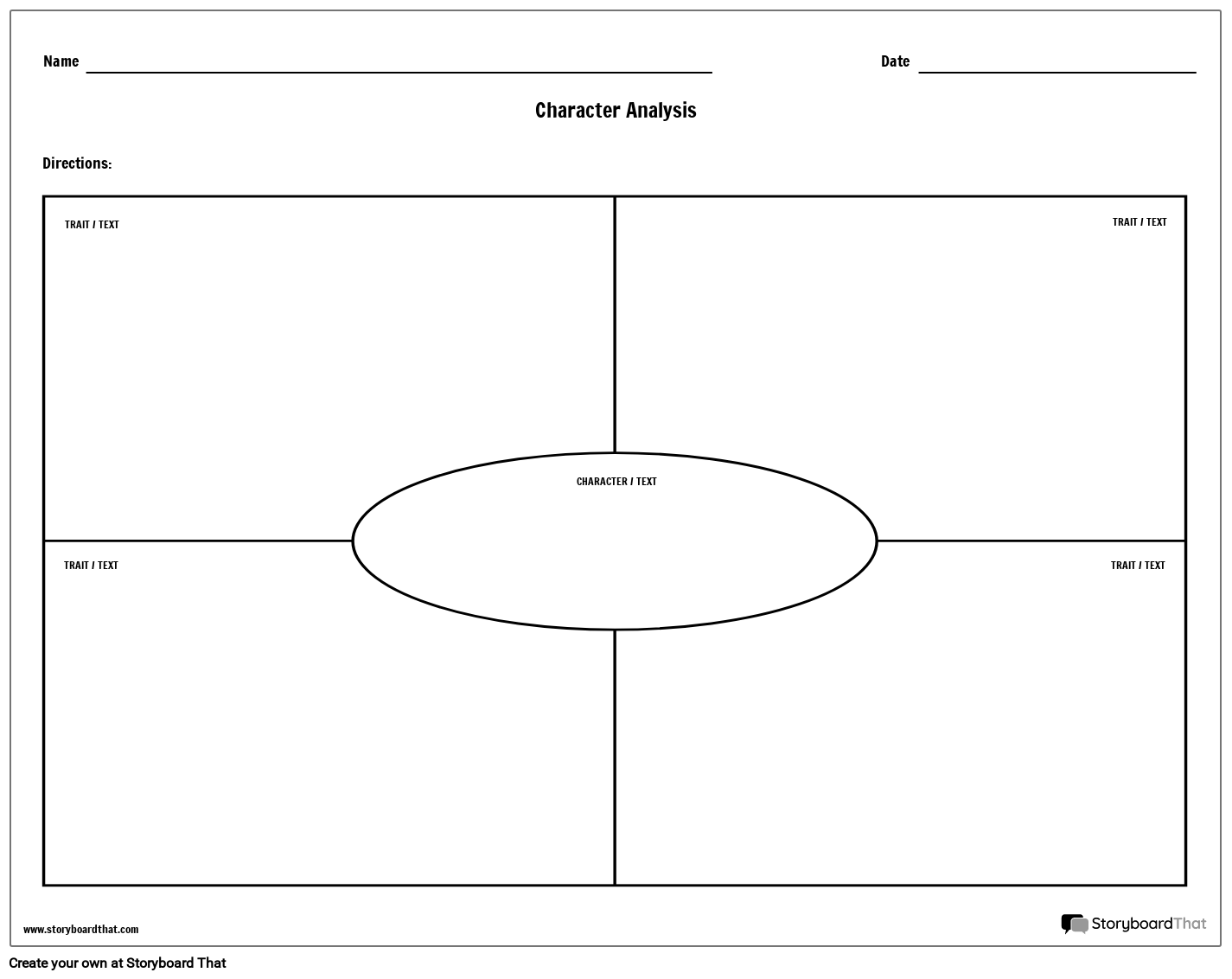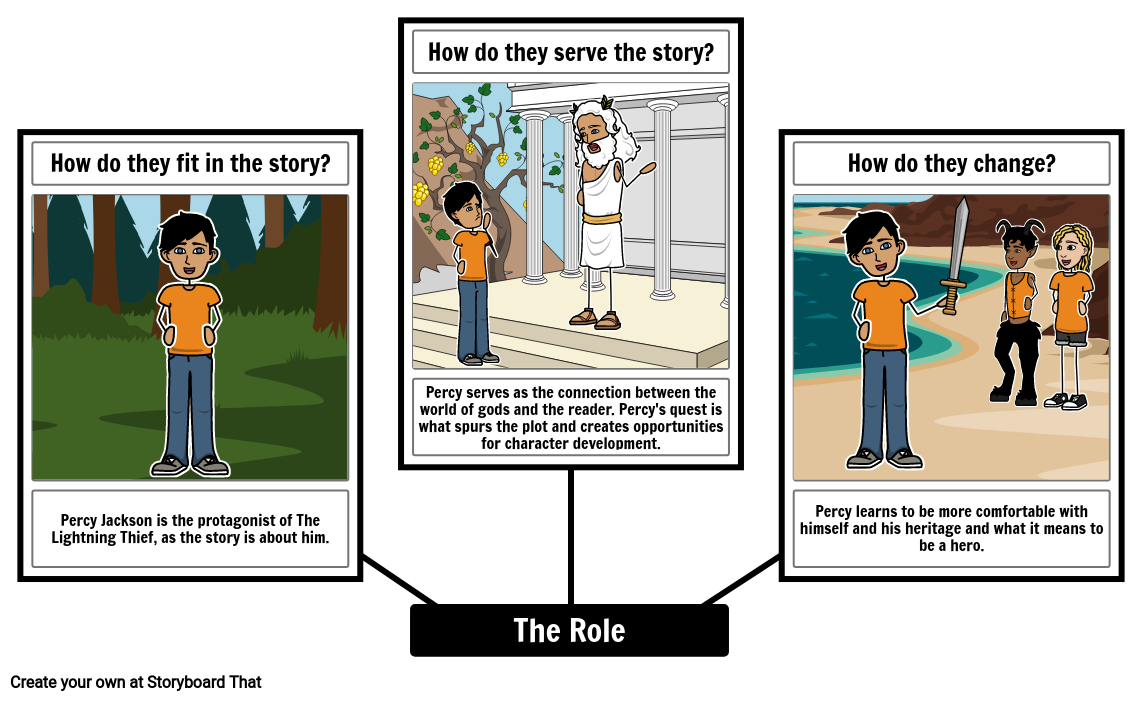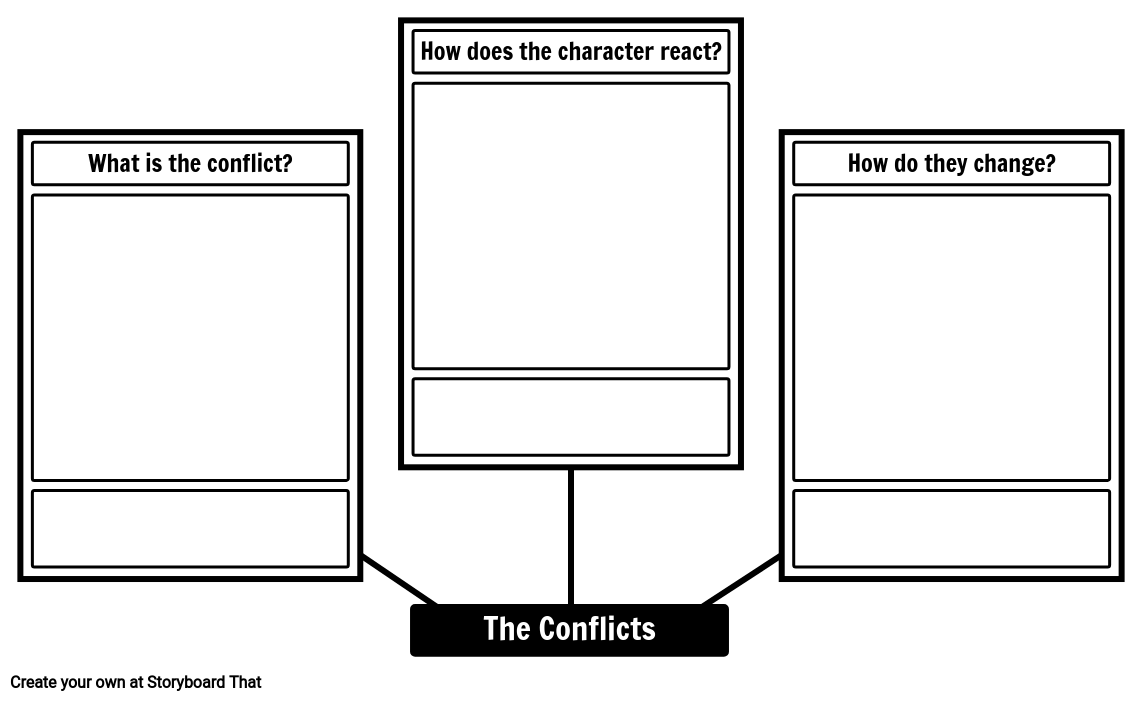Without characters, there is no story. Without depth, the characters don't always contribute enough to the story, if at all. While character maps allow readers to track information about each character while reading, a character analysis lets them go deeper into the role they play in the story, the conflicts they encounter, and their traits, whether external or internal.
Writing a Character Analysis
Usually character analyses are a more in-depth assignment or short essay that require the student to think critically about one or more characters and make inferences from a careful reading of the text. It helps to have ways to visually organize the different parts of a character analysis with storyboards, graphic organizers, or with a character analysis worksheet. From there, the student can formulate their essay!
The Role
Defining the role, or function, of a character is an important first step. Are they the protagonist? The antagonist? The mentor? Do they change? Considering why a character may or may not change and how this affects character traits and conflicts is going to be important in a final analysis. You can ask students questions to guide them through the process of in depth analysis.
- What type of role does the character play in the story?
- How do they serve the story or other characters?
- Based on your initial read of the character, do they even change at all, or do they remain exactly the same as they were at the beginning?
The Traits
If asked to describe the character, what sort of words would you use to describe them? Are they well educated, impulsive, or quiet? These answers contribute to the personality of the character and how they behave. They offer insight into why a character might make a certain decision, and alert us if something seems out of character. For instance, a quiet and cowardly character might suddenly make an impulsive or brave choice in the face of something. Why would they suddenly change?
- What physical traits define the character?
- How do they behave?
- Do they often fight other characters or are they overly helpful?
- How do they speak? What insight can you gain from their words?
The Conflicts
Without conflict in a story, nothing changes. Conflicts, no matter the type, spur character development in at least one, if not all, of the characters in the story. When considering conflict in regards to an analysis, consider the following:
- What conflict(s) does the character encounter?
- What type of conflict is it?
- How does the character react?
- How is the character changed (or not changed) by the conflict?
Character Maps
Character maps are a helpful tool for students to use as they're reading, although they can also be used after completing a book. In this activity, students will create a character map of the characters in the story, paying close attention to the physical attributes and the traits of both major and minor characters. They can also provide detailed information regarding the challenges the character faces, the challenges the character imposes, and the importance of the character to the plot of the story.
To scaffold or tailor this activity, teachers can change the questions, add more questions (the character map layout can be found under "Scenes" -> "Patterns"), provide the names of characters they want students to track, or let students start from scratch! Teachers may also provide the visuals for each character or let students pick their own from the Characters tab. Be sure to update the student instructions as necessary!
- What are the Character's Physical/Character Traits?
- How does this character interact with the other characters in the story?
- What challenges does this character face?
What Next?
Many elements of these three main ideas will influence each other to offer further insight into a character. By creating a template for them, students will be able to keep track of the character while actively reading instead of having to comb back through when they've finished. They'll be able to easily see what connections exist between the information, and synthesize that into a comprehensive essay. Create scaffolded digital worksheets or use the spider map templates above as a starting point. You'll be surprised at what incredible things your students will find.
Related Activities
How to Write a Character Analysis Essay
Understand the Role of the Character
Begin by defining the role of the character in the story. Determine whether they are the protagonist, antagonist, mentor, or another type of character. Consider how their role contributes to the overall story and other characters. Analyze whether the character undergoes any changes throughout the story or remains the same.
Identify and Describe the Character's Traits
Describe the character's traits by considering their personality, behavior, physical attributes, and speech. Use descriptive words to depict the character's qualities and explain how these traits shape their actions and decisions. Analyze any inconsistencies or changes in the character's behavior and examine the reasons behind them.
Explore the Conflicts Encountered by the Character
Examine the conflicts faced by the character and their significance in the story. Identify the type of conflicts, such as internal or external, and analyze how the character responds to these challenges. Assess the impact of the conflicts on the character's development and whether they undergo any transformations or remain unchanged.
Create a Character Map
Utilize a character map to visually organize information about the character. Include details about the character's physical attributes, traits, interactions with other characters, and challenges faced. Consider using pre-designed character map templates or creating a custom map to suit your analysis requirements. Adapt the questions and layout of the character map based on the specific needs of the assignment.
Synthesize the Analysis into an Essay
Take the gathered information from the character analysis and synthesize it into a comprehensive essay. Use the template or character map as a reference to maintain coherence and ensure all relevant connections and insights are included. Structure the essay with an introduction, body paragraphs discussing different aspects of the character analysis, and a conclusion that summarizes the key findings.
Frequently Asked Questions about Character Analysis Essays
What is a character analysis essay?
A character analysis essay is an assignment that requires the student to critically analyze one or more characters in a text and make inferences based on their traits, role in the story, and conflicts they encounter.
Why is it important to define the role of a character in a character analysis?
Defining the role of a character is important because it helps the student understand the character's purpose in the story and how they relate to other characters. It can also help identify if the character undergoes any changes and how it affects their traits and conflicts.
What are some questions to guide students in analyzing the role of a character?
Some questions to guide students in analyzing the role of a character are: What type of role does the character play in the story? How do they serve the story or other characters? Based on your initial read of the character, do they even change at all, or do they remain exactly the same as they were at the beginning?
- Czar Nicholas II • Museum of Photographic Arts Collections • License No known copyright restrictions (http://flickr.com/commons/usage/)
- Karl-Marx-Stadt auf Trab - Friedenslauf am Karl-Marx-Monument • Uwe Kaufmann1 • License Attribution (http://creativecommons.org/licenses/by/2.0/)
- Kazan temple and Historical muzeum • akk_rus • License Attribution (http://creativecommons.org/licenses/by/2.0/)
- Marx at Highgate • [Duncan] • License Attribution (http://creativecommons.org/licenses/by/2.0/)
- STALIN-angry-JPG • snowlepard • License Attribution (http://creativecommons.org/licenses/by/2.0/)
- Trotsky cor 06 • Luiz Fernando / Sonia Maria • License Attribution (http://creativecommons.org/licenses/by/2.0/)
© 2024 - Clever Prototypes, LLC - All rights reserved.
StoryboardThat is a trademark of Clever Prototypes, LLC, and Registered in U.S. Patent and Trademark Office










